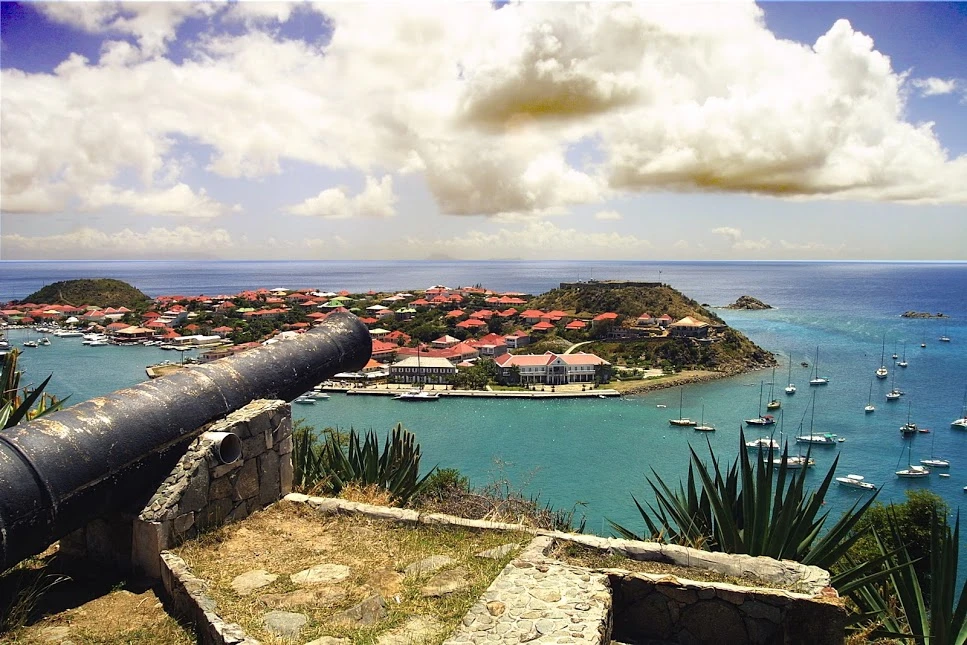St. Barts, a gem in the Caribbean Sea, possesses a history as captivating as the island itself. From ancient indigenous roots to colonial encounters, each chapter of St. Barths’ history unfolds like a page in a thrilling adventure book. Let’s embark on a journey through time, uncovering the stories and people that have shaped this enchanting island.
History of St. Barths
St. Barths – renowned for its stunning beaches, luxurious allure, and reputation as the place to be seen – harbors a past full of twists and turns, far beyond the glitz and glamour of today.
Before the Europeans Showed Up
Long before the arrival of European ships, indigenous groups, probably the Taíno and Arawak people, likely called St. Barths home. While the details of their lives remain somewhat shrouded in mystery, archaeologists are constantly unearthing new clues that shed light on their presence.
In 1493, Christopher Columbus encountered the island, christening it after his brother, Bartholomew.
French Settlers, Carib Raids, and a Swedish Interlude
The year 1648 saw the arrival of French settlers, led by Jacques Gentes, who envisioned establishing cacao plantations on the island. However, their aspirations were met with resistance from the Carib people, who were already established in the region. In 1656, a fierce Carib attack forced the French settlers to flee.
Undeterred, the French West India Company regained control of St. Barths, only to sell it to Sweden in 1784 to settle debts. Under Swedish rule, the island flourished as a bustling trading hub. The Swedish legacy is still visible today in the island’s architecture and cultural nuances.
In 1878, the people of St. Barths voted in a referendum to return to French control.
St. Barths Today: A Blend of History and High Life
Today, St. Barths, an overseas collectivity of France since 2007, is renowned for its luxurious resorts and its allure for the rich and famous. Yet, beneath the veneer of modern extravagance, the island’s rich history peeks through. From Swedish street names to diverse architectural styles, St. Barths’ past is as vibrant as its present.
What is St. Barths history?
St. Barths’ history is a captivating tapestry woven from indigenous roots, colonial encounters, and cultural fusion.
Pre-Columbian Era
Before the arrival of Europeans, St. Barths was likely inhabited by indigenous communities, with archaeological evidence suggesting the presence of both the Arawak and Carib tribes. Cave drawings and unearthed artifacts whisper tales of their heritage.
European Arrival and Colonial Struggles
Christopher Columbus’ “discovery” of St. Barths in 1493 marked the beginning of European influence on the island. French settlers, enticed by the prospect of cultivating cacao, arrived in 1648 but faced resistance from the Carib people, leading to conflict and temporary abandonment.
The Swedish Chapter
In a surprising turn of events, France sold St. Barths to Sweden in 1784. The Swedes, with their prowess for trade, transformed the island into a thriving free port, leaving an indelible mark on its architecture and culture, particularly evident in the distinctive Scandinavian flair of some buildings.
Return to French Rule and Modern Era
France reclaimed St. Barths in 1878, and it has remained under French control ever since. The island’s unique blend of Caribbean charm and European elegance, layered upon its rich history, makes it a captivating destination.
Why is St Barts so famous?
St. Barts’ fame lies in its unique blend of Caribbean relaxation and French sophistication. This alluring combination, coupled with breathtaking natural beauty, has captivated travelers from around the globe.
Cultural Fusion
The island’s French heritage is evident in its language, architecture, and cuisine, while the influence of Caribbean island life adds a vibrant energy. This harmonious fusion creates a unique ambiance that distinguishes St. Barts from other destinations.
Pristine Beaches and Azure Waters
St. Barts is practically synonymous with picture-perfect beaches. Shell Beach, renowned for its abundance of seashells, and Gouverneur Beach, a secluded paradise for sun-seekers, are just two examples of the island’s coastal splendor.
Luxury and Exclusivity
St. Barts has earned a reputation as a playground for the rich and famous. Upscale boutiques, world-class restaurants, and luxurious accommodations cater to a discerning clientele seeking exclusivity and indulgence.
Diverse Activities
Beyond its luxurious offerings, St. Barts boasts a surprising array of activities. From hiking trails winding through lush hillsides to hidden coves perfect for snorkeling and diving, the island caters to adventurers and leisure-seekers alike.
Here’s a glimpse at St. Barts’ allure:
| Feature | Description |
|---|---|
| Culture | A captivating blend of French and Caribbean influences permeates the island’s language, architecture, cuisine, and overall ambiance. |
| Beaches | St. Barts is home to some of the world’s most beautiful beaches, known for their pristine white sand and crystal-clear turquoise waters. |
| Luxury and Exclusivity | The island is a haven for celebrities and discerning travelers seeking high-end accommodations, designer shopping, and world-class dining. |
| Diverse Activities | St. Barts offers a variety of activities, from hiking and watersports to exploring charming villages and cultural attractions. |
St. Barts’ enduring appeal lies in its ability to seamlessly blend relaxation and excitement, offering a taste of paradise that appeals to a wide range of travelers.
Who were the native people of St Barts?
Before the arrival of Europeans, indigenous communities called St. Barths home. Based on archaeological findings, experts believe that the Arawak and Carib tribes were among those who inhabited the island.
The Arawak People
The Arawak people, known for their peaceful nature and agricultural skills, migrated from Venezuela and settled throughout the Antilles islands around 2,000 years ago.
The Carib People
The Caribs, known for their more assertive nature, arrived in the Caribbean later and established a strong presence in the Lesser Antilles. They referred to St. Barts as “Ouanalao,” meaning “pelican,” and likely made periodic visits to the island. The discovery of Carib camps during the construction of the Gustave III airport in St. Jean provides further evidence of their presence.
What is the ethnicity of St Barts?
St. Barts’ history has shaped its present-day ethnic composition, which differs from many other Caribbean islands. The majority of the population is Caucasian, primarily of European descent, a direct result of the island’s history as a French colony.
French Influence and Absence of Plantations
The French language is widely spoken on the island, and French influence is deeply embedded in its culture. Unlike many other Caribbean islands that relied heavily on plantation agriculture and the forced labor of enslaved Africans, St. Barts did not have large-scale plantations. This historical difference significantly influenced the island’s ethnic makeup.
A Unique Cultural Blend
Today, St. Barts embodies a fascinating blend of European heritage and Caribbean vibrancy. French traditions mingle with the rhythms and colors of the islands, creating a truly unique cultural cocktail.
Why is St. Barths so Expensive?
St. Barts has a reputation for being an expensive destination, and several factors contribute to its high prices.
Exclusivity and High-End Tourism
The island caters to a wealthy clientele, offering luxury resorts, Michelin-starred restaurants, and designer boutiques. This emphasis on exclusivity and high-end tourism inevitably drives up prices.
Remote Location and Import Dependency
St. Barths’ remote location in the Caribbean Sea means that almost everything must be shipped in, resulting in higher transportation costs for goods and services.
Tax-Free Luxury Goods
Paradoxically, while everyday items can be expensive, luxury goods are tax-free on St. Barts. This unusual policy further contributes to the island’s high-end appeal.
Limited Accessibility
Reaching St. Barths often involves connecting through other islands, as there are no direct flights from many major cities. This limited accessibility adds to the travel costs.
Limited Space and High Demand
The island’s small size (just eight square miles) makes real estate incredibly valuable. Limited space coupled with high demand allows hotels and villas to charge a premium for accommodations.
These factors combine to make St. Barts an expensive destination, but for many travelers, the island’s beauty, exclusivity, and luxurious offerings are worth the price tag.
What is the difference between St Barts and St. Barths?
Both “St. Barts” and “St. Barths” refer to the same place – the island officially named Saint-Barthélemy. The variation in spelling reflects the evolution of language and the abbreviation of place names.
French and English Variations
French speakers, being geographically and culturally closer to Saint-Barthélemy, typically use the full name or a slightly shortened form, “Saint-Barth.” English speakers have adopted the abbreviated form “St. Barts,” which is easier to pronounce and has become widely accepted.
Official vs. Common Usage
While the official name is “Saint-Barthélemy,” in everyday conversation, both “St. Barts” and “St. Barths” are perfectly acceptable and widely understood.
What is the history of the St. Bartholomew’s Day massacre?
The St. Bartholomew’s Day massacre, a dark chapter in French history, stands as a chilling reminder of the devastating consequences of religious intolerance and unchecked power.
Background and Rising Tensions
In 16th-century France, tensions simmered between Catholics and Huguenots (French Protestants). The attempted assassination of Admiral Gaspard de Coligny, a prominent Huguenot leader, on August 24, 1572, ignited the fury that led to the massacre.
The Massacre Unfolds
King Charles IX, influenced by his advisors, particularly his mother, Catherine de Medici, feared the growing influence of the Huguenots. Under immense pressure and misled by false information, the king ordered the elimination of Huguenot leaders.
Catholic mobs, fueled by years of religious hatred, rampaged through Paris, brutally murdering Huguenots. The massacre spread throughout France, leaving thousands dead and a legacy of horror and trauma.
Questions and Consequences
The St. Bartholomew’s Day massacre continues to fascinate and horrify historians. Questions about the exact role of key figures like Catherine de Medici and the degree of premeditation versus mob violence continue to be debated.
The massacre had profound and lasting consequences for France. It deepened religious divisions, ignited further wars of religion, and left an indelible scar on the nation’s psyche.
What is a cool fact about Saint Barthelemy?
For a brief but fascinating period in its history, Saint Barthelemy belonged to Sweden. In the 18th century, France traded the island to Sweden in exchange for favorable trading rights. The Swedish legacy is still visible today, especially in the architecture of Gustavia, the island’s capital.
The colorful houses, sturdy forts, and even some street names reflect the Swedish influence, adding a unique dimension to St. Barts’ cultural tapestry.
What is the real name of St Barts?
The real, official name of the island paradise commonly known as St. Barts is Saint-Barthélemy – in French, of course!
Nicknames and Linguistic Evolution
As with many places, the official name has been shortened and adapted over time. French speakers often use “Saint-Barth” while English speakers have adopted “St. Barts.” Both are widely accepted and understood.
A Name That Endures
Interestingly, while the island has seen various rulers and influences, some form of the name “St. Barts” has persisted throughout history.
What is the culture of St. Barths?
St. Barths’ culture is a vibrant tapestry woven from a rich blend of influences, reflecting its history as a crossroads of cultures.
Creole Heritage
At the heart of St. Barths’ culture is its Creole heritage. This unique blend of African, French, and Indian traditions finds expression in the island’s music, dance, cuisine, and customs.
Architectural Fusion
St. Barths’ architecture tells a story of its own. Colonial-style homes with intricate wrought-iron balconies speak to its French past, while the iconic Swedish Belltower in Gustavia stands as a reminder of its Swedish chapter.
Culinary Delights
The island’s culinary scene is a delight for the senses. Creole cuisine takes center stage, blending flavors and spices in a way that embodies the island’s spirit. Fresh seafood, tropical fruits, and locally grown vegetables add to the culinary tapestry.
A Culture in Constant Evolution
It’s important to remember that cultures are not static; they evolve. St. Barths’ culture continues to be shaped by internal and external forces, making it a dynamic and fascinating subject of study.
Key Points of St. Barths History:
- Pre-European: Likely inhabited by indigenous Taíno and Arawak people.
- 1493: Christopher Columbus discovered and named the island after his brother Bartholomew.
- 1648: French settlers attempted to establish cacao plantations.
- 1656: Carib raiders attacked, forcing French settlers to abandon the island.
- 1784: French West India Company sold St. Barths to Sweden to settle debts.
- Swedish Rule: Period of prosperity and trade activity, leaving architectural and cultural influences.
- 1878: People of St. Barths voted to return to French control.
- Present: Overseas collectivity of France, known for luxury tourism and its unique blend of historical and modern elements.
- Clovis Unified School District Calendar: A Parent’s Guide to Key Dates & Updates (2023-2026) - November 22, 2024
- Bossier Parish Schools Calendar 2024-2025: A Parent’s Guide to Key Dates & Resources - November 22, 2024
- 2024-2025 Caddo Parish School Calendar: Key Dates and Information - November 22, 2024
















